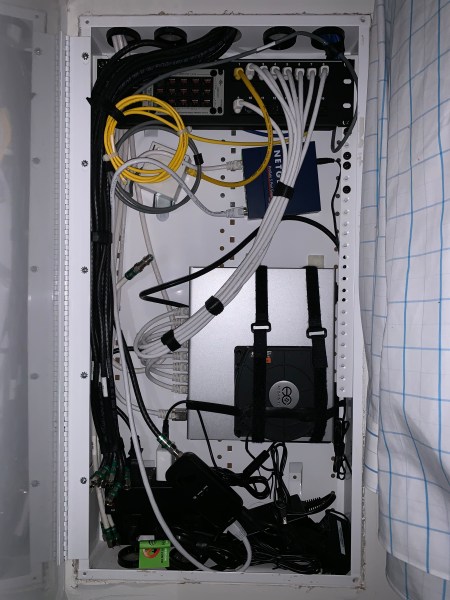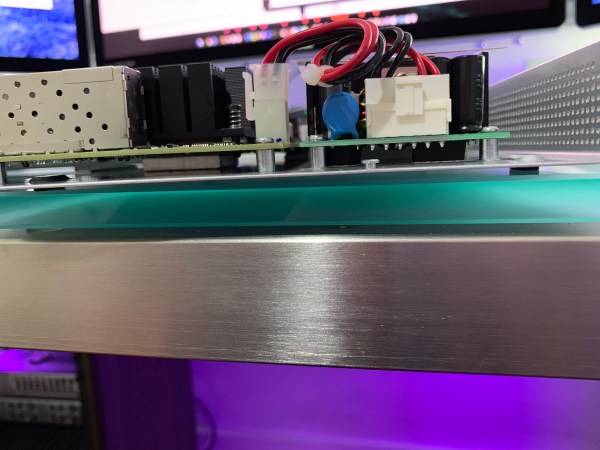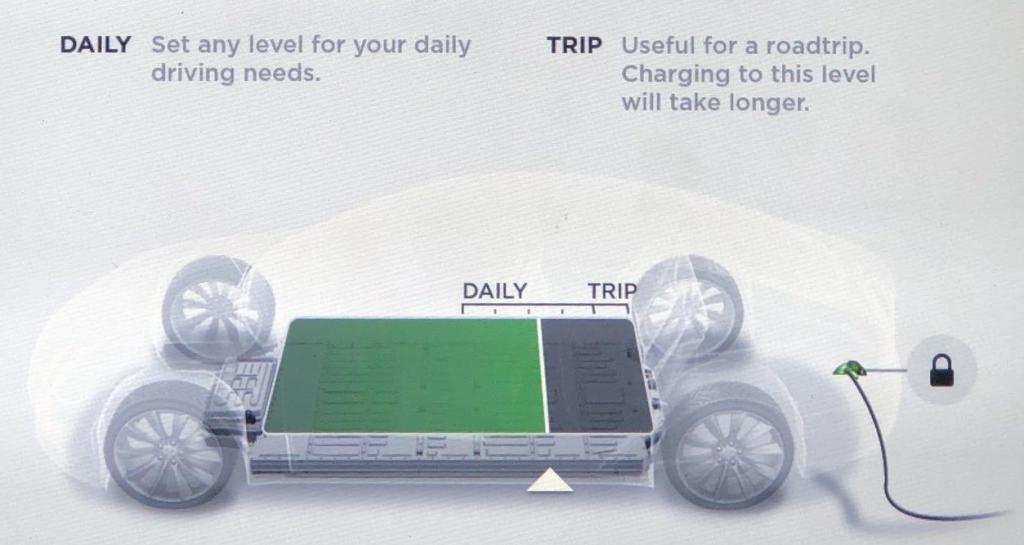After hearing about Apple discontinuing further development of the Airport Extreme, I decided to switch to Ubiquiti’s UniFi line of wireless gear about a year and a half ago. The internet is full of great reviews, so I didn’t need much prodding.
Well, suffice it to say that I’m a fan. I can get into the details later, but, for now, this post is about one very specific problem and how I fixed it to my satisfaction.
The problem
I am in the fortunate/unfortunate position of having all my cabling home run back into an On-Q structured enclosure. This enclosure has very little room for extra cooling or power.

My On-Q enclosure
These enclosures are only a few inches deep and a bit hard to work in. Not anywhere near as nice as having a whole room or a closet dedicated to a rack mount. But, on the other hand, there’s a small ecosystem of On-Q stuff that makes them still much better than nothing at all … provided you are willing to pay extra for everything.

UniFi Switch 8 (150W)
The switch I have in there now is Ubiquiti’s US-8-150W. It provides 802.3at Power over Ethernet to all of the ports in my condo. I’m lucky this product exists, because the next step up is rack mount sized and wouldn’t fit very well in the enclosure.
Anyway, a lot of people have noticed how hot the US-8-150W gets … myself included. At times, I would notice the switch getting up to 73C in the controller software when I was out for the day and the AC wasn’t running. Locating the switch in an enclosure like this is basically the exact opposite of what the documentation tells you to do.
Now … 73C isn’t that bad, but I know most parts are rated around 70C and my OCD was kicking in. So I set out to figure out how to get this thing cooler.
Research
I found the following threads (and a few others):
US-8-150W Fan Mod
Is there a problem with US-8-150W switches?
US-8-150W Temperature Range – Is the datasheet wrong?
From these threads, I found a few creative approaches … several folks who simply pointed various fans in different ways at the switch, some who attached cpu heatsinks to the top case (both active and passive), and even some who bothered to open up the case and try adding an active fan.
In any case, it was nice to see the concern about heat was shared by quite a few people and not just myself. The US-8-150W, if you didn’t know, is passively cooled. This is one of its great assets, since it runs silent, but also contributes to a high operating temperature.
Potential solutions
With some extra information under my belt, I considered the following options.
- Attach passive heatsinks: An appealing option due to the somewhat lower invasiveness and not requiring any moving parts or power. However, removing the adhesive could be a bit of a pain if I ever needed to use this switch in a different environment or resell it.
- Attach a low profile blower fan to the top case: A very appealing option once I discovered the right fan – the AC Infinity MultiFan S2. It has rubber feet and adjustable speeds, plus the profile was about an inch. Perfect fit!
- Attach a regular fan to the top case: The AC Infinity MultiFan S3 is basically just like the S2, but with a regular fan. While it would be a better option in an open air environment (larger fans produce more airflow with less noise, especially compared to blowers), it just wasn’t a very practical option due to the low profile of the enclosure. I ruled this out pretty quickly once I found the blower fan existed.
- Attach some small fans to the side vents: I ruled this out because, while it would be effective blowing into the case, trying to mount them for effective airflow and still support the switch on its side in the enclosure would be very awkward. Also, I wanted to avoid any potential dust buildup inside the switch if it wasn’t necessary for my target temperature.
- Attach some small fans to the unused enclosure cabling holes to vent air: In an enclosure like this, it seemed like a good idea to try actually moving air through the enclosure instead of just blowing hot air around inside. While I didn’t decide against this, I figured I could try other easier approaches first before going down this path.
In the end, I decided to order the passive heatsinks (along with various thermal pads and adhesives) and the blower fan and experiment with the results.
Initial testing
The first thing I did was establish a baseline of 69C. This was at night with the enclosure closed so that heat would build up to a steady state inside. All further tests were run by allowing the switch inside to reach a steady state temperature.
First, I tested the fan on the top case, as seen in my enclosure photo above. I was able to strap it on pretty easily. With the fan speed set to low, this lowered the temperature to 65C. Not quite as good as I had hoped.
Next, I raised the fan speed to medium. This lowered the temperature to a mere 64C. Since I didn’t want a noisy fan to begin with, and raising the fan speed wasn’t scaling very well, I didn’t bother raising the speed to the high setting.
At this point, I was poking around the switch and noticed that the bottom was unusually hot … hotter than the top had ever felt! So I tried something different and placed the fan UNDER the switch’s bottom. This was somewhat awkward to pull off in the enclosure, but certainly doable. To my surprise, this dropped the temperature to 60C!
Now that piqued my curiosity. It seemed pretty clear that the CPU was thermally interfaced to the bottom of the switch. It was time to open the thing up anyway.
Opening the US-8-150W
Opening the US-8-150W is pretty easy. Simply unscrew the two screws on the back, and slide the top case forward a bit to unlatch. Then lift the top off, being sure to disconnect the header for the front panel as you do so. There’s some resistance sliding the top forward that may require a bit of prying, but that’s really all you need to do.

The CPU is thermally interfaced to the bottom of the switch
Voila! Confirmation, as you can see on the middle left beneath the CPU. Funny because basically every attempt I’d seen at cooling the US-8-150W involved cooling the top case.
This brought me to my final step. I didn’t really want to flip the switch over to cool it … and, besides, was there any reason I couldn’t just interface the passive heatsink inside to the top case? I had several 100mm x 100mm x 1mm thick thermal pads that I had intended to use with the passive heatsinks, so I decided to see what I could do with them.

Thermal pads applied
The passive heatsink is about 60mm x 60mm. Simply cutting a single 100mm x 100mm pad into 4 pieces and stacking them up wasn’t perfect, but it would be enough for my testing.
After laying down the pads one at a time and gingerly sliding the case off and on, I determined a 4 mm thickness seemed adequate. Also, because the top case doesn’t go straight down onto the bottom case, I found that placing the pads offset about 10mm to the front was a good idea. By doing this, putting the top case back on and sliding the case back to latch it would “smush” the pad into approximately the right position. (P.S. If I did this again, I’d just use a 4mm thick pad)
Finally, the moment of truth. After putting everything back together, the CPU temp was a mere 62C without any fan attached! The top case also had a much hotter area above the CPU as you would expect. Simply adding the thermal pad had dropped the temperature 7 degrees!
Frankly, that level of temperature drop was good enough for me. But since I still had the fan around, I placed it directly over the top case hotspot on low speed. This reduced the CPU temp to 59C.
At this point, I didn’t feel like I needed any more improvements, and closed everything up for good.
Conclusion
First, the thermal interface to the bottom of the switch is important. It means that if you want a zero effort way to improve cooling, you should try to cool the bottom of the case first and not the top (although blowing air through the side vents should still be quite effective). Most of the ad-hoc approaches I saw were probably unaware of this fact.
Second, it turns out that simply interfacing the passive heatsink to the top case via a 4mm thermal pad is a shockingly effective way to lower CPU temperatures inside the US-8-150W. Now you’re utilizing both the bottom and the top surface area to dissipate heat, plus exposure to free air flow is greater as well. This all has the bonus of requiring no moving parts or extra power and is basically a “strictly better” kind of fix.
Third, I am quite sure that this mod could be performed on other UniFi products as well, especially the US-8, US-8-60W and USG-3P. I don’t know if my cooling requirements for those products and others require me to go perform a mod on those just yet, but you may find it useful.







 In a
In a